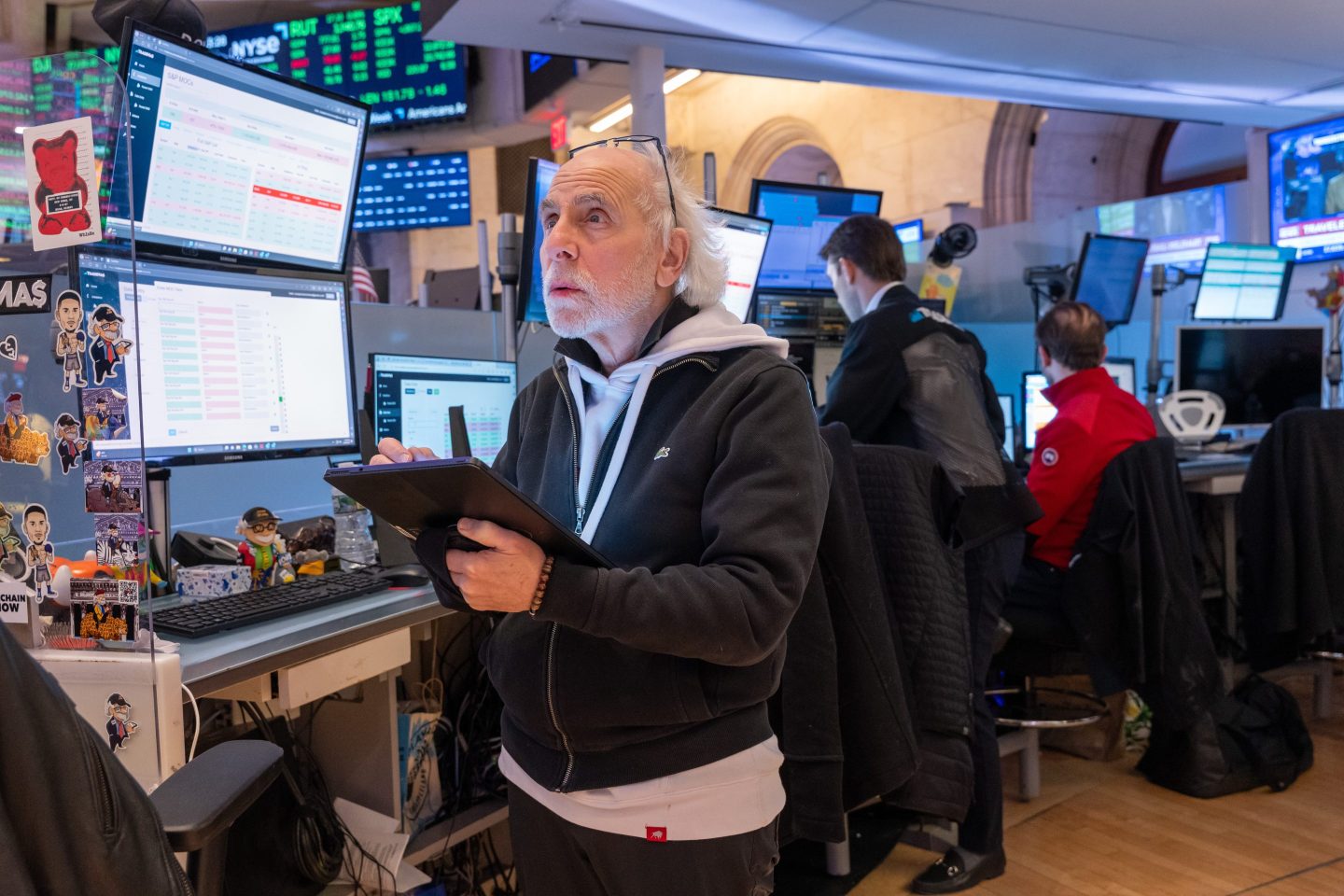
每年,當大多數美國人都在裝飾圣誕樹、制作姜餅屋的時候,一些有市場頭腦的記者卻在忙著針對大型投資銀行對來年股市和經濟的預測進行詳細報道。美國銀行(Bank of America)、摩根大通(JPMorgan Chase)、高盛(Goldman Sachs),所有這些大公司都在年終展望文章中占據顯著位置,但有趣的是,亞德尼研究公司(Yardeni Research)的創始人埃德·亞德尼(Ed Yardeni)也在其中。
亞德尼并沒有經營投資銀行,其公司提供類似于精品賣方投資咨詢服務,但他多年來擔任首席投資策略師、經濟學教授和美聯儲經濟學家的經驗,為他贏得了華爾街頂級分析師的聲譽。這意味著亞德尼經常做出有先見之明的預測,值得密切關注。畢竟,當大多數經濟學家仍在預測經濟衰退時,他是少數幾個對去年股市反彈做出準確預測的分析師之一。
近日,亞德尼撰文概述了本十年股市(和經濟)的三種回歸情景。這三種“歷史先例”中的兩種將是投資者喜聞樂見的,而另一種則可能是一場噩夢。
以下是華爾街最受尊敬的專家之一對2024年美國經濟和股市重返未來的看法。
20世紀20年代——60%的幾率
一系列積極的經濟數據——包括樂觀的通脹數據、零售銷售報告和消費者信心調查——使得三大股指中的兩大股指在上周創下歷史新高。亞德尼表示,美國經濟極有可能走向“咆哮的二十年代”。
這位資深經濟學家和市場觀察人士表示,利率下降、通脹消退,以及人工智能和機器人等新技術的應用所帶來的生產率增長相結合,最終將有助于迎來一個增長和富足的時代。
自2020年以來,亞德尼一直在強調“咆哮的二十年代”的觀點,最近他提出,由于即將到來的經濟繁榮,標準普爾500指數將在2025年底飆升25%,達到6000點。
他解釋說,這一情景的“基本前提”是,“長期勞動力短缺”將迫使企業在未來十年依靠技術創新來提高生產率,而從人工智能到3D打印等創新技術都將實現這一目標。生產率的提高應能帶來持續的經濟增長、“抑制”通脹,提高利潤率,而長期勞動力短缺將有助于工資增長。
自2022年3月以來,美聯儲為了對抗通脹而采取加息舉措,在“咆哮的二十年代”情景中,美聯儲也可能采取降息舉措。亞德尼認為,股市投資者將賺得盆滿缽滿。他認為,“咆哮的二十年代”有60%的可能性成為現實。
20世紀70年代——20%的幾率
即使是運行良好的經濟機器,地緣政治沖突也會對其造成破壞。20世紀70年代,1973年贖罪日戰爭和1979年伊朗革命之后的兩次石油價格沖擊,使通脹率在長達十多年的時間里居高不下。如今(在更短的時間段內),俄烏沖突以及以色列-哈馬斯戰爭有可能讓我們重返那個時代。
2022年俄烏沖突爆發時,消費者和企業已經體會到天然氣和石油價格飆升帶來的影響。在過去的幾個月里,胡塞武裝在以色列-哈馬斯戰爭期間襲擊了紅海的貨船,導致海運費飆升。
不過,亞德尼指出,盡管出現了這些情況,但通脹仍在放緩。原油市場供應充足,這有助于防止出現像20世紀70年代紅海危機期間那樣嚴重的油價沖擊。
亞德尼表示:“仍有可能出現20世紀70年代發生的第二次能源通脹沖擊。”不過,他補充說,“如果中東沖突局勢持續失控,油價可能再次飆升。在這種情況下,美聯儲將被迫加息,從而導致經濟衰退。”
對于股市投資者來說,這種通脹反彈和經濟衰退的情景將是一場噩夢。亞德尼寫道,在這十年中,他們最終將虧得一塌糊涂。
20世紀90年代——20%的幾率
隨著人工智能和機器人技術的蓬勃發展,當前的經濟時代與20世紀90年代的互聯網泡沫也有一些相似之處。
亞德尼解釋說:“在這一時代,美聯儲開始擔心通脹率跌破2%,即使經濟表現依然良好,美聯儲也會通過大幅降息來應對。”
他補充說,如果美聯儲迅速降息,結果將是“股市崩盤,首當其沖的是科技股”。這很容易讓人聯想起20世紀90年代的互聯網泡沫,當時互聯網股票飆升至難以為繼的高度。但亞德尼警告說,這種情景的最終結果也很像20世紀90年代,即崩盤。
他認為,低利率將導致科技股和其他資產出現“泡沫”。消費者因這一泡沫而不斷增加的凈資產將轉化為“另一輪價格通脹”,迫使美聯儲加息,像2000年初那樣戳破泡沫。
對于投資者來說,這種情景聽起來可能很可怕,但它很可能會帶來一些重大機遇。亞德尼寫道:“在這種情況下,非理性繁榮將卷土重來。”他認為,科技股的估值可能會飆升到2000年初以來從未見過的水平。"對于股票投資者來說,只要這一情況持續下去,就會帶來繁榮。”(財富中文網)
譯者:中慧言-王芳
每年,當大多數美國人都在裝飾圣誕樹、制作姜餅屋的時候,一些有市場頭腦的記者卻在忙著針對大型投資銀行對來年股市和經濟的預測進行詳細報道。美國銀行(Bank of America)、摩根大通(JPMorgan Chase)、高盛(Goldman Sachs),所有這些大公司都在年終展望文章中占據顯著位置,但有趣的是,亞德尼研究公司(Yardeni Research)的創始人埃德·亞德尼(Ed Yardeni)也在其中。
亞德尼并沒有經營投資銀行,其公司提供類似于精品賣方投資咨詢服務,但他多年來擔任首席投資策略師、經濟學教授和美聯儲經濟學家的經驗,為他贏得了華爾街頂級分析師的聲譽。這意味著亞德尼經常做出有先見之明的預測,值得密切關注。畢竟,當大多數經濟學家仍在預測經濟衰退時,他是少數幾個對去年股市反彈做出準確預測的分析師之一。
近日,亞德尼撰文概述了本十年股市(和經濟)的三種回歸情景。這三種“歷史先例”中的兩種將是投資者喜聞樂見的,而另一種則可能是一場噩夢。
以下是華爾街最受尊敬的專家之一對2024年美國經濟和股市重返未來的看法。
20世紀20年代——60%的幾率
一系列積極的經濟數據——包括樂觀的通脹數據、零售銷售報告和消費者信心調查——使得三大股指中的兩大股指在上周創下歷史新高。亞德尼表示,美國經濟極有可能走向“咆哮的二十年代”。
這位資深經濟學家和市場觀察人士表示,利率下降、通脹消退,以及人工智能和機器人等新技術的應用所帶來的生產率增長相結合,最終將有助于迎來一個增長和富足的時代。
自2020年以來,亞德尼一直在強調“咆哮的二十年代”的觀點,最近他提出,由于即將到來的經濟繁榮,標準普爾500指數將在2025年底飆升25%,達到6000點。
他解釋說,這一情景的“基本前提”是,“長期勞動力短缺”將迫使企業在未來十年依靠技術創新來提高生產率,而從人工智能到3D打印等創新技術都將實現這一目標。生產率的提高應能帶來持續的經濟增長、“抑制”通脹,提高利潤率,而長期勞動力短缺將有助于工資增長。
自2022年3月以來,美聯儲為了對抗通脹而采取加息舉措,在“咆哮的二十年代”情景中,美聯儲也可能采取降息舉措。亞德尼認為,股市投資者將賺得盆滿缽滿。他認為,“咆哮的二十年代”有60%的可能性成為現實。
20世紀70年代——20%的幾率
即使是運行良好的經濟機器,地緣政治沖突也會對其造成破壞。20世紀70年代,1973年贖罪日戰爭和1979年伊朗革命之后的兩次石油價格沖擊,使通脹率在長達十多年的時間里居高不下。如今(在更短的時間段內),俄烏沖突以及以色列-哈馬斯戰爭有可能讓我們重返那個時代。
2022年俄烏沖突爆發時,消費者和企業已經體會到天然氣和石油價格飆升帶來的影響。在過去的幾個月里,胡塞武裝在以色列-哈馬斯戰爭期間襲擊了紅海的貨船,導致海運費飆升。
不過,亞德尼指出,盡管出現了這些情況,但通脹仍在放緩。原油市場供應充足,這有助于防止出現像20世紀70年代紅海危機期間那樣嚴重的油價沖擊。
亞德尼表示:“仍有可能出現20世紀70年代發生的第二次能源通脹沖擊。”不過,他補充說,“如果中東沖突局勢持續失控,油價可能再次飆升。在這種情況下,美聯儲將被迫加息,從而導致經濟衰退。”
對于股市投資者來說,這種通脹反彈和經濟衰退的情景將是一場噩夢。亞德尼寫道,在這十年中,他們最終將虧得一塌糊涂。
20世紀90年代——20%的幾率
隨著人工智能和機器人技術的蓬勃發展,當前的經濟時代與20世紀90年代的互聯網泡沫也有一些相似之處。
亞德尼解釋說:“在這一時代,美聯儲開始擔心通脹率跌破2%,即使經濟表現依然良好,美聯儲也會通過大幅降息來應對。”
他補充說,如果美聯儲迅速降息,結果將是“股市崩盤,首當其沖的是科技股”。這很容易讓人聯想起20世紀90年代的互聯網泡沫,當時互聯網股票飆升至難以為繼的高度。但亞德尼警告說,這種情景的最終結果也很像20世紀90年代,即崩盤。
他認為,低利率將導致科技股和其他資產出現“泡沫”。消費者因這一泡沫而不斷增加的凈資產將轉化為“另一輪價格通脹”,迫使美聯儲加息,像2000年初那樣戳破泡沫。
對于投資者來說,這種情景聽起來可能很可怕,但它很可能會帶來一些重大機遇。亞德尼寫道:“在這種情況下,非理性繁榮將卷土重來。”他認為,科技股的估值可能會飆升到2000年初以來從未見過的水平。"對于股票投資者來說,只要這一情況持續下去,就會帶來繁榮。”(財富中文網)
譯者:中慧言-王芳
Every year, when most Americans are decorating Christmas trees and building gingerbread houses, a few markets-minded reporters are busy detailing the stock market and economic forecasts of giant investment banks for the coming year. Bank of America, JPMorgan Chase, Goldman Sachs, all of the big names are featured prominently in these year-end outlook articles—but interestingly, so is Ed Yardeni, founder of Yardeni Research.
Yardeni doesn’t run an investment bank, offering instead something more like a boutique sell-side investment consulting firm, but his years of experience as a chief investment strategist, economics professor, and Fed economist have earned him a reputation as one of Wall Street’s top analysts. This standing means Yardeni’s often prescient forecasts merit close attention. After all, he was one of the few analysts to accurately call last year’s stock market rally when most economists were still forecasting recession.
In a Sunday note, Yardeni outlined three throwback scenarios for stocks (and the economy) this decade. Two of these three “historical precedents” will be music to the ears of investors, but the other could be a nightmare.
Here’s how one of Wall Street’s most respected minds sees the U.S. economy and stock market heading back to the future in 2024.
The 1920s — 60% odds
With a string of positive economic data—including optimistic inflation figures, retail sales reports, and consumer sentiment surveys—helping lift two of the three major stock market indices to a record high last week, Yardeni argued Sunday that the U.S. economy is most likely headed for a “Roaring 2020s” scenario.
A combination of falling interest rates, fading inflation, and a productivity boom due to the deployment of new technologies like AI and robotics will ultimately help usher in an era of growth and abundance, according to the veteran economist and market watcher.
Yardeni has been pushing this Roaring 2020s idea since 2020, and recently made the case that the S&P 500 will soar 25% to 6,000 by the end of 2025 as a result of the upcoming economic boom.
On Sunday, he explained that his “basic premise” is that a “chronic shortage of labor” will force companies to rely on technological innovations to boost productivity this decade—and those innovations, from AI to 3d printing, will do just that. Rising productivity should lead to sustained economic growth, “subdued” inflation, and higher profit margins, while the chronic nature of the labor shortage will help wages grow.
After raising interest rates to fight inflation since March 2022, the Federal Reserve is also likely to cut rates in a Roaring 2020s scenario. And stock market investors would do “very well,” according to Yardeni, who believes there is a 60% chance that the Roaring 2020s becomes a reality.
The 1970s — 20% odds
Geopolitics can throw a wrench in even the best of economic machines. In the 1970s, there were two oil price shocks after the Yom-Kippur War of 1973 and the Iranian Revolution of 1979 that helped keep inflation elevated for over a decade. Now, (in an even shorter span of years), the Russia-Ukraine war and Israel-Hamas war have threatened a flashback to that era.
Consumers and businesses already felt the effects of surging natural gas and oil prices when the Russia-Ukraine war kicked off in 2022. And over the past few months, ocean shipping rates have surged after Houthi attacks on cargo vessels in the Red Sea amid the Israel-Hamas war.
Still, Yardeni noted on Sunday that inflation is moderating despite these developments. The crude market is also well supplied, which has helped prevent a serious oil price shock like what was seen during the 1970s amid the Red Sea crisis so far.
“There is still a risk of a second inflationary energy shock as occurred during the 1970s,” Yardeni argued Sunday, however, adding that “if the conflicts in the Middle East continue to spin out of control, oil prices could soar again. The Fed would be forced to raise interest rates in this scenario and cause a recession.”
For stock market investors, this inflation rebound and recession scenario would be a nightmare. They would end up doing “very badly” this decade, Yardeni wrote.
The 1990s — 20% odds
With AI and robotics booming, a few parallels can also be drawn between the current economic era and the dot-com bubble of the 1990s.
“In this one, the Fed becomes concerned that inflation is falling below 2%, and responds by aggressively cutting interest rates even though the economy continues to perform well,” Yardeni explained.
If the Fed were to quickly cut interest rates, the result would be “a meltup in the stock market with technology stocks leading the way,” he added. That’s awfully reminiscent of the dot-com boom in the 1990s, when internet stocks surged to unsustainable heights. But Yardeni warned that the end result of this scenario would also look a lot like the 90s—and that means a crash.
He argued that low interest rates would cause a “bubble” in tech stocks and other assets. The increasing net worth of consumers because of this bubble would then turn into “another round of price inflation,” forcing the Fed to raise rates and pop the bubble just like in early 2000.
This scenario may sound dire for investors, but it would likely offer some serious opportunity. “Irrational exuberance would make a comeback in this scenario,” Yardeni wrote, arguing tech stocks could soar to valuations not seen since early 2000. “It’s lots of fun for stock investors while it lasts.”






